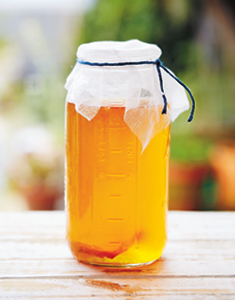
Kombucha
Originating in China and Russia, this slightly fermented sweet tea packs a serious probiotic punch and is really delicious. It is not hard to prepare, but it will take you a few times to get used to the process. To make it you need a slightly odd-looking thing called a scoby (a ‘symbiotic community of bacteria and yeast’), and this is what will ferment your sweet tea; it is also referred to as a ‘mother’ culture. You can buy these online, at good food co-ops and health food stores, or from a kombucha-making friend.
There are two stages to making kombucha, and all up it will take you about a week. The first stage will give you a slightly carbonated drink. The second stage is the fun part where you get to flavour the tea however you’d like, and make it even fizzier.
MAKES: 1.75 litres (60 fl oz/7 cups)
INGREDIENTS
3 tea bags of black, green or white tea, or any combination of these
500 ml (17 fl oz/2 cups) boiling water, plus 1.5 litres (52 fl oz/6 cups) cool filtered water
220 g (7¾ oz/1 cup) raw or granulated white sugar
1 scoby, also known as a ‘mother’ culture
125 ml (4 fl oz/½ cup) kombucha tea from a previous batch, or from a store-bought unflavoured, unpasteurised kombucha
EQUIPMENT
small teapot or saucepan
sieve and a bowl for straining
1 x 2 litre (64 oz) glass jar, no lid required
clean tightly woven cloth, for covering the jar
rubber band or kitchen string, for securing the cloth
small jar for storing some kombucha and scobies for your next batch
1 x 1.5 litre (52 fl oz) clean bottle for storing the finished brew
KOMBUCHA METHOD
1. |
Make the tea: Brew the tea in a small teapot or saucepan with the boiling water for about 5 minutes. Add the sugar and stir to dissolve. Strain into your 2 litre (64 oz) brewing jar and add the cool filtered water; the mixture needs to be less than 30˚C (86˚F) so as not to damage the microbes in the scoby, so leave until completely cool. |

|
|
2. |
Add the culture: Remove your scoby from its ‘scoby hotel’ (or your previous batch). Add it to the brewing jar, along with your ready-made kombucha tea. The scoby may sink or float in the mix – either is fine. |

|
3. |
Cover and leave: Cover the jar with the tightly woven cloth and secure with a rubber band or kitchen string. Place the jar in a spot away from direct sunlight, where the temperature will stay between 20–28˚C (68–82˚F). |
4. |
Check in: After 3–5 days you will notice cloudy or milky white patches forming on the surface of the scoby. This is a new baby scoby being formed. Once the new scoby is covering the liquid, take a clean teaspoon and taste the brew. This is where you’ll get to know what you like – sweet or a little tart, both are fine, and it is up to you when you want to stop fermenting your tea. I like it best when the acidity is similar to that of a sweet orange juice, and it is slightly fizzy. |

5. |
Strain and drink, or add flavours: Reserve 250 ml (9 fl oz/1 cup) of your brew to start your next batch. You can now either strain the rest into a clean, airtight 1.5 litre (52 fl oz) bottle and store it in the fridge, where it will keep for up to 1 week, or you can add some extra flavourings and a second ferment stage to your fresh brew. |
KOMBUCHA TIPS
To take a break from brewing: Store your scobies in a kombucha hotel! This is a jar filled with scobies and kombucha tea from a previous batch, sealed with a lid and kept in the fridge. A scoby will keep well this way for 1–2 months.
Splitting a scoby: Once you have a living, breathing scoby in your possession, you can easily peel off a layer to give to a friend so they can join in the fun.
HOW TO USE
- Great as a base for cocktails … which turns the cocktail into a healthy drink, right?
- A perfect drink for the mid-afternoon slump.
- If you’ve let it ferment a little long and it errs on the side of sour instead of sweet, it is great in salad dressings in place of vinegar.